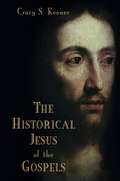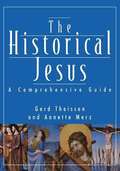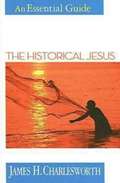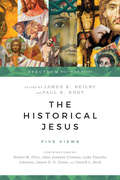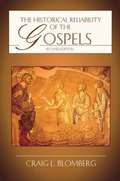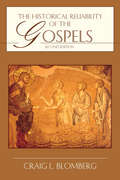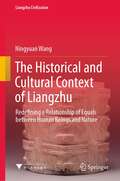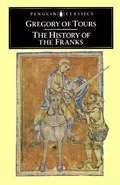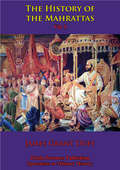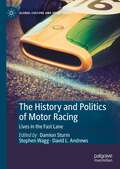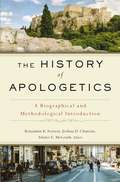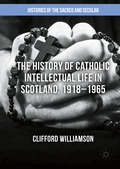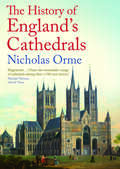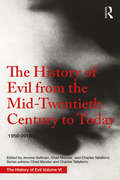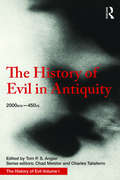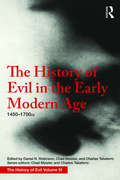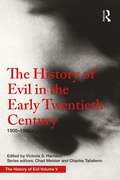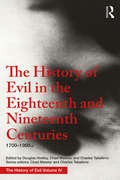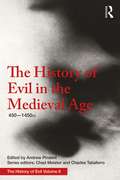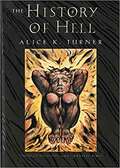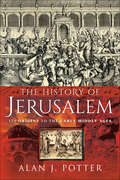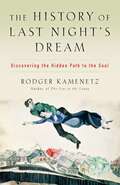- Table View
- List View
The Historical Jesus of the Gospels
by Craig S. KeenerThe earliest substantive sources available for historical Jesus research are in the Gospels themselves; when interpreted in their early Jewish setting, their picture of Jesus is more coherent and plausible than are the competing theories offered by many modern scholars. So argues Craig Keener in The Historical Jesus of the Gospels. In exploring the depth and riches of the material found in the Synoptic Gospels, Keener shows how many works on the historical Jesus emphasize just one aspect of the Jesus tradition against others, but a much wider range of material in the Jesus tradition makes sense in an ancient Jewish setting. Keener masterfully uses a broad range of evidence from the early Jesus traditions and early Judaism to reconstruct a fuller portrait of the Jesus who lived in history.
The Historical Jesus: A Comprehensive Guide
by Gerd Theissen Annette MerzIn the continuing quest for the elusive but compelling figure of Jesus of Nazareth, Gerd Theissen and Annette Merz's authoritative yet engaging book is the single most helpful resource to date. <P><P>Comprehensively detailing the sources for our knowledge of Jesus, Theissen and Merz fully explore the historical and social context of Jesus and his activity. They then unfold what we can know about Jesus' characteristics as a charismatic teacher, a Jewish prophet, a healer, a teller of parables, and an ethical teacher. Finally, they examine closely the historical questions surrounding Jesus' last supper, his violent death, the accounts of Easter, and the beginnings of Christology. <P>Beholden to neither ancient dogma nor contemporary fantasy, written in a clear style with a variety of learning aids, The Historical Jesus will provide students, teachers, and other individuals with a fascinating and reliable guide into this most exciting field of Jesus research.
The Historical Jesus: An Essential Guide (Essential Guides #26)
by James H. CharlesworthRecent years have seen an explosion of talk about the historical Jesus from scholarly settings as well as media outlets (including sensational TV documentaries and national magazines). How is the student of the Bible to assess these various claims about Jesus? And what difference does knowledge of his time and place make for Christian faith, theological thinking, and historical research? James Charlesworth presents the solid results of modern study into the life and times of Jesus, especially regarding the role of the Essenes, the significance of the Dead Sea Scrolls, the nature of messianic expectation, and much more. No one today is better equipped than James Charlesworth to lead students through the thickets of controversy that surround much of contemporary historical Jesus research.This Abingdon Essential Guide will fulfill the need for a brief, substantive, yet highly accessible introduction to this core area of New Testament studies. Drawing on the best in current scholarship, written with the need of students foremost in mind, addressed to learners in a number of contexts, this Essential Guide will be the first choice of those who wish to acquaint themselves or their students with the broad scope of issues, perspectives, and subject matters relating to modern quests for the historical Jesus. It will also be a preferred text for those who need or want to refresh their knowledge regarding the context within which Jesus lived in preparation for leading church discussion groups in studies of the Gospels.
The Historical Jesus: Five Views (Spectrum Multiview Book Series)
by John Dominic Crossan Darrell L. Bock Luke Timothy Johnson Robert M. Price James D. DunnThe Historical Jesus: Five ViewsThe Historical Jesus: Five Views
The Historical Reliability of the Gospels (Second Edition)
by Craig L. BlombergCraig Blomberg's The Historical Reliability of the Gospels has a useful antidote to many of the toxic effects of skeptical criticism of the Gospels. Offering a calm, balanced overview of the history of Gospel criticism, especially that of the late twentieth century. This new edition in light of new developments with numerous additions to the footnotes and two added appendixes.
The Historical Reliability of the Gospels: Issues And Commentary
by Craig L. BlombergFor over twenty years, Craig Blomberg's The Historical Reliability of the Gospels has provided a useful antidote to many of the toxic effects of skeptical criticism of the Gospels. Offering a calm, balanced overview of the history of Gospel criticism, especially that of the late twentieth century, Blomberg introduces readers to the methods employed by New Testament scholars and shows both the values and limits of those methods. He then delves more deeply into the question of miracles, Synoptic discrepancies and the differences between the Synoptics and John. After an assessment of noncanonical Jesus tradition, he addresses issues of historical method directly. This new edition has been thoroughly updated in light of new developments with numerous additions to the footnotes and two added appendixes. Readers will find that over the past twenty years, the case for the historical trustworthiness of the Gospels has grown vastly stronger.
The Historical and Cultural Context of Liangzhu: Redefining a Relationship of Equals between Human Beings and Nature (Liangzhu Civilization)
by Ningyuan WangThis book clarifies the advent of Liangzhu Culture and analyses the morphology, structure and internal social organization of grass-root settlements, medium-size settlements and the ancient city of Liangzhu, as well as the religious beliefs, ideology and power mechanisms represented by jade. Further, the book explains how the low-lying location and humid environment in the water-net plain area prompted the creation of man-made platforms or pillars, forming small and densely settled residential areas, and ultimately the water villages of southern China. Developments between man and nature accelerated the process of civilization, leading to the polarization of social classes and pyramid-shaped residential structures containing cities, towns and villages. Offering unique insights into the social vitality and structure of Liangzhu society, the book is one of the most important academic works on interpreting the origins of Liangzhu Civilization and investigating Chinese Civilization.
The History Of The Franks
by Lewis Thorpe Gregory Of ToursWritten following the collapse of Rome's secular control over western Europe, the History of Gregory (c. AD 539-594) is a fascinating exploration of the events that shaped sixth-century France. This volume contains all ten books from the work, the last seven of which provide an in-depth description of Gregory's own era, in which he played an important role as Bishop of Tours. With skill and eloquence, Gregory brings the age vividly to life, as he relates the exploits of missionaries, martyrs, kings and queens - including the quarrelling sons of Lothar I, and the ruthless Queen Fredegund, third wife of Chilperic. Portraying an age of staggering cruelty and rapid change, this is a powerful depiction of the turbulent progression of faith at a time of political and social chaos.
The History Of The Mahrattas - Vol I (The History Of The Mahrattas #1)
by James DuffThe power of India reached its pre-British Raj height under the Maratha Empire or the Maratha Confederacy which was an Indian imperial power that existed from 1674 to 1818. At its peak, the empire covered much of India, encompassing a territory of over 2.8 million km². The Marathas are credited for ending the Mughal rule in India.The Marathas were a yeoman warrior group from the western Deccan that rose to prominence during the rule of the Adil Shahi dynasty and Ahmadnagar Sultanate. The empire was founded by Shivaji Bhosle, who formally crowned himself Chhatrapati ("Emperor") with Raigad as his capital in 1674, and successfully fought against the Mughal Empire. The Maratha Empire waged war for 27 years with the Mughals from 1681 to 1707, which became the longest war in the history of India. Shivaji, pioneered "Shiva sutra" or Ganimi Kava (guerrilla tactics), which leveraged strategic factors like demographics, speed, surprise and focused attack to defeat his bigger and more powerful enemies. After the death of the Mughal Emperor Aurangzeb, the empire expanded greatly under the rule of the Peshwas. The empire at its peak stretched from Tamil Nadu in the south, to Peshawar (modern-day Pakistan) on the Afghanistan border in the north, and Bengal and Andaman Islands in east. In 1761, the Maratha army lost the Third Battle of Panipat to Abdali’s Afghan Durrani Empire, which halted their imperial expansion. Ten years after Panipat, young Madhavrao Peshwa reinstated the Maratha authority over North India. In a bid to effectively manage the large empire, he gave semi-autonomy to the strongest of the knights, which created a confederacy of Maratha states. In 1775, the British East India Company intervened in a succession struggle in Pune, which became the First Anglo-Maratha War. Marathas remained the preeminent power in India until their defeat in the Second and Third Anglo-Maratha wars (1805–1818), which left the British East India Company in control of most of India.
The History and Environmental Impacts of Hunting Deities: Supernatural Gamekeepers and Animal Masters (Conflict, Environment, and Social Complexity)
by Richard J. ChaconThis edited volume analyzes the belief in supernatural gamekeepers and/or animal masters of wildlife from a cross-cultural perspective. It documents the antiquity and widespread occurrence of the belief in supernatural gamekeepers at the global level. This interdisciplinary volume documents both the antiquity and the widespread geographical distribution of this belief along with surveying the various manifestations of this cosmology by way of studies from Europe, Asia, Africa, and North and South America. Some chapters explore the manifestations of this belief as they appear in petroglyphs/pictographs and other forms of material culture. Others focus on the environmental impacts of these beliefs/rituals and prescribed foraging restrictions by analyzing how they affect game harvests. The internationally recognized scholars in this volume assess the efficacy of this particular form of traditional ecological knowledge (TEK) and investigate if adherence to the belief in animal masters actually causes hunters to refrain from overharvesting wild game and thereby contributes to sustainable hunting practices. This volume is of interest to anthropologists, archaeologists and other social scientists researching traditional ecological knowledge (TEK), indigenous conservation, biodiversity, and sustainability practices, and animal deities.
The History and Politics of Motor Racing: Lives in the Fast Lane (Global Culture and Sport Series)
by David L. Andrews Stephen Wagg Damion SturmThis book explores the history and politics of motor racing, one of the most popular and lucrative elements in the international sport industry. Written by a group of international scholars and motor racing specialists it discusses the sport’s origins, the relationship of motor racing to nation building and modernity (noting its links to fascism and dictatorship), the links between motor racing and the automobile industry, motor racing and the politics both of gender and of race, motor racing, the media and postmodernity, and motor racing, the spatial and globalization. This book speaks to scholars in history, politics, sport studies, the sociology of sport, sport management and cultural studies, along with the many lay readers who are interested in the relationship between motor sport and society.
The History of Apologetics: A Biographical and Methodological Introduction
by Alister McGrath Joshua Chatraw Benjamin ForrestThe History of Apologetics follows the great apologists in the history of the church to understand how they approached the task of apologetics in their own cultural and theological context. Each chapter looks at the life of a well-known apologist from history, unpacks their methodology, and details how they approached the task of defending the faith. By better understanding how apologetics has been done, readers will be better able to grasp the contextualized nature of apologetics and apply those insights to today's context. The History of Apologetics covers forty-four apologists.
The History of Catholic Intellectual Life in Scotland, 1918-1965
by Clifford WilliamsonThisbook offers an innovative approach to the character of the intellectual life ofCatholics in Scotland. It looks at Catholic attempts to fight the appeal ofcommunism amongst the working classes in interwar Scotland, it analysesdevelopments in the devotional life of Scottish Catholics and it discusses theunique theological contribution made by Scottish clerics. Chapters also explorethe increasing presence of Catholics in Scotland in higher education and theirrole in shaping change within the Catholic Church. Finally, readers will havethe opportunity to learn more about the previously under-researched CatholicIntelligentsia, and the debate within it on the place of Catholicism in thehistory of Scotland. The History ofCatholic Intellectual Life in Scotland, 1918-1965 presents the domestic context of thechanging character of Scottish Catholicism, as well as the context of changes inEuropean Catholicism.
The History of England's Cathedrals
by Nicholas OrmeThe first history of all the English cathedrals, from Birmingham and Bury St Edmunds to Worcester and York Minster England&’s sixty-two Anglican and Catholic cathedrals are some of our most iconic buildings, attracting millions of worshippers and visitors every year. Yet although much has been written about their architecture, there is no complete history of their life and activities. This is the first such book to provide one, stretching from Roman times to the present day. The History of England&’s Cathedrals explains where and why they were founded, who staffed them, and how their structures evolved. It describes their worship and how this changed over the centuries, their schools and libraries, and their links with the outside world. The history of these astonishing buildings is the history of England. Reading this book will bring you face to face with the Anglo-Saxons, Vikings, Normans, Reformation, Civil War, Victorian England, World War Two, and finally modern democracy.
The History of Evil from the Mid-Twentieth Century to Today: 1950–2018 (History of Evil)
by Jerome GellmanThis sixth volume of The History of Evil charts the era 1950–2018, with topics arising after the atrocities of World War II, while also exploring issues that have emerged over the last few decades. It exhibits the flourishing of analytic philosophy of religion since the War, as well as the diversity of approaches to the topic of God and evil in this era. Comprising twenty-one chapters from a team of international contributors, this volume is divided into three parts, God and Evil, Humanity and Evil and On the Objectivity of Human Judgments of Evil. The chapters in this volume cover relevant topics such as the evidential argument from evil, skeptical theism, free will, theodicy, continental philosophy, religious pluralism, the science of evil, feminist theorizations, terrorism, pacifism, realism and relativism. This outstanding treatment of the history of evil will appeal to those with particular interests in the ideas of evil and good
The History of Evil in Antiquity: 2000 BCE - 450 CE (History of Evil)
by Charles Taliaferro Chad Meister Tom AngierThis first volume of The History of Evil covers Graeco-Roman, Indian, Near Eastern, and Eastern philosophy and religion from 2000 BCE to 450 CE. This book charts the foundations of the history of evil among the major philosophical traditions and world religions, beginning with the oldest recorded traditions: the Vedas and Upaniṣads, Confucianism and Daoism, and Buddhism, and continuing through Graeco-Roman and Judaeo-Christian schools of thought. This cutting-edge treatment of the history of evil at its crucial and determinative inception will appeal to those with particular interests in the ancient period and early theories and ideas of evil and good, as well as those seeking an understanding of how later philosophical and religious developments were conditioned and shaped.
The History of Evil in the Early Modern Age: 1450–1700 CE (History of Evil)
by Daniel RobinsonThe third volume of The History of Evil encompasses the early modern era from 1450–1700. This revolutionary period exhibited immense change in both secular knowledge and sacred understanding. It saw the fall of Constantinople and the rise of religious violence, the burning of witches and the drowning of Anabaptists, the ill treatment of indigenous peoples from Africa to the Americas, the reframing of formal authorities in religion, philosophy, and science, and it produced profound reflection on good and evil in the genius of Shakespeare, Milton, Bacon, Teresa of Avila, and the Cambridge Platonists. This superb treatment of the history of evil during a formative period of the early modern era will appeal to those with interests in philosophy, theology, social and political history, and the history of ideas.
The History of Evil in the Early Twentieth Century: 1900–1950 CE (History of Evil)
by Victoria S. HarrisonThe fifth volume of The History of Evil covers the twentieth century from 1900 through 1950. The period saw the maturation of intellectual movements such as Pragmatism and Phenomenology, and the full emergence of several new academic disciplines; all these provided novel intellectual tools that were used to shed light on a human capacity for evil that was becoming increasingly hard to ignore. An underlying theme of this volume is the effort to reconstruct an understanding of human nature after confidence in its intrinsic goodness and moral character had been shaken by world events. The chapters in this volume cover globally relevant topics such as education, propaganda, power, oppression, and genocide, and include perspectives on evil drawn from across the world. Theological and atheistic responses to evil are also examined in the volume. This outstanding treatment of approaches to evil at a determinative period of modernity will appeal to those with interests in the intellectual history of the era, as well as to those with interests in the political, philosophical and theological movements that matured within it.
The History of Evil in the Eighteenth and Nineteenth Centuries: 1700–1900 CE (History of Evil)
by Douglas HedleyThe fourth volume of The History of Evil explores the key thinkers and themes relating to the question of evil in eighteenth and nineteenth centuries. The very idea of "evil" is highly contentious in modern thought and this period was one in which the concept was intensely debated and criticized. The persistence of the idea of evil is a testament to the abiding significance of theology in the period, not least in Germany. Comprising twenty-two chapters by international scholars, some of the topics explored include: Berkeley on evil, Voltaire and the Philosophes, John Wesley on the origins of evil, Immanuel Kant on evil, autonomy and grace, the deliverance of evil: utopia and evil, utilitarianism and evil, evil in Schelling and Schopenhauer, Friedrich Nietzsche and the genealogy of evil, and evil and the nineteenth-century idealists. This volume also explores a number of other key thinkers and topics within the period. This outstanding treatment of the history of evil at the crucial and determinative inception of its key concepts will appeal to those with particular interests in the ideas of evil and good.
The History of Evil in the Medieval Age: 450-1450 CE (History of Evil)
by Andrew PinsentThe second volume of The History of Evil explores the philosophy of evil in the long Middle Ages. Starting from the Augustinian theme of evil as a deprivation or perversion of what is good, this period saw the maturation of concepts of natural evil, of evil as sin involving the will, and of malicious agents aiming to increase evil in general and sin in particular. Comprising fifteen chapters, the contributions address key figures of the Christian Middle Ages or traditions sharing some similar cultural backgrounds, such as medieval Judaism and Islam. Other chapters examine contemporaneous developments in the Middle East, China, India and Japan. The volume concludes with an overview of contemporary transpositions of Dante, illustrating the remarkable cultural influence of medieval accounts of evil today. This outstanding treatment of the history of evil at the crucial and determinative inception of its key concepts will appeal to those with particular interests in the ideas of evil and good.
The History of Hell (Harvest Book Series)
by Alice K. Turner Donadio Donadio OlsonA “lively...generously illustrated” (Washington Post Book World) survey of how, over the past four thousand years, religious leaders, artists, writers, and ordinary people in the West have visualized Hell-its location, architecture, purpose, and inhabitants. Illustrations; full-color inserts.
The History of Jerusalem: Its Origins to the Early Middle Ages
by Alan J. PotterFascinating revelations of the parts played by David, Solomon, Judas Maccabee, Pompey, Cleopatra, Justinian, and others in the making of the city.Jerusalem is one of the oldest cities in the world, with evidence of an original settlement dating back more than 4,000 years. Vitally important was the supply of water provided by the Gihon Spring, in a land that normally experienced rainfall only from November to March. Since then this Middle Eastern city has been attacked and devastated on numerous occasions.Former rulers include King David, who established the City of David, and his son Solomon, who expanded Jerusalem and built the first Great Temple on Mount Moriah. Destruction 2,600 years ago saw most of the inhabitants exiled to Babylon, but as the Jewish diaspora returned, the Temple and city were rebuilt. Wars between the Ptolemaic and Seleucid successors of Alexander the Great seemed endless, but the resistance of the Maccabee brothers eventually led to the glorious reign of the Hasmonean kings.Roman interference and the enforcement of the despotic Herod the Great as king led inevitably to the catastrophic Jewish/Roman wars, and Jerusalem was once again destroyed. Christianity eventually facilitated a reinvigorated Byzantine Jerusalem, which became one of the world’s most beautiful cities. The bubonic plague was survived, but a new low saw the Persians sack the city before Heraclius triumphantly returned Christ’s True Cross to Jerusalem.The History of Jerusalem: Its Origins to the Early Middle Ages is the first of its kind to examine in detail the rich history of Jerusalem during antiquity up to the year 630 CE. This in-depth account goes further than other volumes in terms of the breadth and scale of events covered, and offers an unbiased but critical appraisal of the colorful history of Jerusalem and the surrounding areas.
The History of Jerusalem: Its Origins to the Early Middle Ages
by Alan J. PotterFascinating revelations of the parts played by David, Solomon, Judas Maccabee, Pompey, Cleopatra, Justinian, and others in the making of the city.Jerusalem is one of the oldest cities in the world, with evidence of an original settlement dating back more than 4,000 years. Vitally important was the supply of water provided by the Gihon Spring, in a land that normally experienced rainfall only from November to March. Since then this Middle Eastern city has been attacked and devastated on numerous occasions.Former rulers include King David, who established the City of David, and his son Solomon, who expanded Jerusalem and built the first Great Temple on Mount Moriah. Destruction 2,600 years ago saw most of the inhabitants exiled to Babylon, but as the Jewish diaspora returned, the Temple and city were rebuilt. Wars between the Ptolemaic and Seleucid successors of Alexander the Great seemed endless, but the resistance of the Maccabee brothers eventually led to the glorious reign of the Hasmonean kings.Roman interference and the enforcement of the despotic Herod the Great as king led inevitably to the catastrophic Jewish/Roman wars, and Jerusalem was once again destroyed. Christianity eventually facilitated a reinvigorated Byzantine Jerusalem, which became one of the world’s most beautiful cities. The bubonic plague was survived, but a new low saw the Persians sack the city before Heraclius triumphantly returned Christ’s True Cross to Jerusalem.The History of Jerusalem: Its Origins to the Early Middle Ages is the first of its kind to examine in detail the rich history of Jerusalem during antiquity up to the year 630 CE. This in-depth account goes further than other volumes in terms of the breadth and scale of events covered, and offers an unbiased but critical appraisal of the colorful history of Jerusalem and the surrounding areas.
The History of Last Night's Dream: Discovering the Hidden Path to the Soul
by Rodger KamenetzOur Dreams Will Never Be the Same AgainInternational bestselling author Rodger Kamenetz believes it is not too late to reclaim the lost power of our nightly visions. He fearlessly delves into this mysterious inner realm and shows us that dreams are not only intensely meaningful, but hold essential truths about who we are. In the end, each of us has the choice to embark on this illuminating path to the soul.
